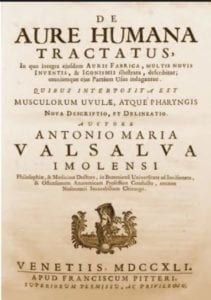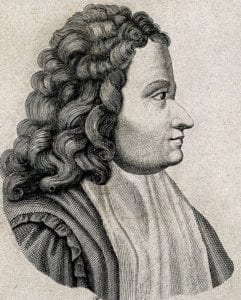Antonio Valsalva qualified in medicine at the University of Bologna in 1687 after studying under Marcello Malpighi, one of the first people to use microscopy in medicine. Valsalva succeeded him in 1697 as professor of anatomy and later of surgery and was also surgeon to the hospital for incurables and mentally ill in Bologna. He was noted for his practice of checking, whenever possible, the findings observed during life with those found at autopsy, a practice he transmitted to his pupil Giovanni Battista Morgagni.
Valsalva’s main interest was the study of hearing, and in 1704 he described the anatomy of the middle and inner ear and of its various structures in a famous book, De aure humana tractatus. He was a skillful surgeon and an accomplished physician; advocated for a humane treatment of patients with mental disorders; described the sinuses in the heart located between the wall of the aorta and the cusps of the aortic valve; carried out experiments on dogs and birds; and observed in the human that lesions on one side of the brain caused its effects on the opposite side of the body.
Valsalva is remembered by having his name attached to the now so-called Valsalva maneuver. This consists of causing an acute rise in intrathoracic and intraabdominal pressure by contracting the abdominal and pelvic floor muscles while stopping expiration at the throat, tongue, lips and nostrils. This is done briefly and automatically in coughing and sneezing, for longer periods in defecation and giving birth, also in heavy lifting, blowing wind instruments, equalizing pressures in the middle ear (especially on airplanes), or during cardiovascular testing.
None of these applications seem to have been Valsalva’s initial intention. It appears from his writings that he used his maneuver in an attempt to prove there were foramina between the ear and the cranial cavity, and also to clear intracranial and middle ear fluids through eardrum perforations. It was an unintended effect that the maneuver became popularized under his name, first in the German literature and then worldwide with its current applications.


Reference
Jellinek EH. The Valsalva manoeuvre and Antonio Valsalva (1666-1723). J Roy. Soc Med, 2006;99:448.

Leave a Reply